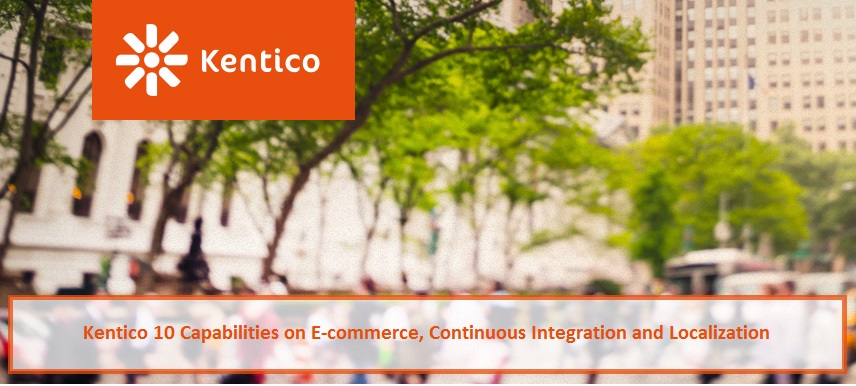Mar 13
2017
Kentico 10 Capabilities on E-commerce, Continuous Integration and Localization
 Kentico Software helps clients create successful websites, online stores, community sites and intranets using Kentico integrated marketing solution. With offices in the United States, United Kingdom and Czech Republic and more than 1,000 partners in 80 countries, Kentico is one of the industry leaders worldwide.
Kentico Software helps clients create successful websites, online stores, community sites and intranets using Kentico integrated marketing solution. With offices in the United States, United Kingdom and Czech Republic and more than 1,000 partners in 80 countries, Kentico is one of the industry leaders worldwide.The Latest version, Kentico 10, having tons of out-of-the-box features, combined with Kentico’s API, Kentico is the affordable and extendable choice for all your web development projects, no matter the size or audience.
Ray Business Technologies’ (“Raybiztech”) is a leading Kentico CMS Solution Partner and has the largest number of Kentico certified developers in the world. Raybiztech is a CMMI Level-3, ISO 27001:2022 Certified Company.
E-commerce
Kentico’s E-commerce solution allows you to create powerful online stores faster and more easily, so you can focus on your sales. With full control over design, Kentico’s E-commerce solution gives you the power to sell globally for greater customer loyalty. Integration with third-party ERPs, CRMs, and payment gateways, and an easy-to-tailor checkout process give you the flexibility and extensibility to let your website grow. While full integration with Online Marketing lets you deliver real-time customer-centric marketing across all channels.Kentico E-commerce can be divided into three major categories:
Managing your store
Products: Manage the products and services that you offer in your on-line store and set them based on your desires:- Product options – Manage options that you added to the offered products. For example, multiple colors, configurations, etc.
- Product variants – Manage variants of your main products. For example, T-shirts in different sizes and colors. Each combination of size and color.
- Manufacturers – Manage manufacturers who make the products and provide the services that you offer in your on-line store.
- Suppliers – Manage suppliers who supply the products and deliver the services that you offer in your on-line store.
- Product workflow – Set up a reviewing and approval process to ensure quality of your website's content and design.
- Catalog discounts – Grant your eligible customers discounts on selected products.
- Order discounts – Grant your eligible customers discounts on their whole shopping.
- Free shipping offers – Grant your eligible customers the benefit of free shipping.
- Volume discounts – Offer better prices to your customers if they purchase specified amounts of given products.
- Buy X Get Y discounts – Offer your customers free or discounted products if they purchase specified products.
- Bundles – Offer and sell your customers multiple products of various kinds as single products for special prices.
Orders: Manage orders that your customers placed while purchasing in your on-line store.
Reports and statistics: View reports and statistics related to your on-line store.
Configuring your store
- Multilingual store: Present the products and services that you offer to your customers in multiple language versions.
- Multiple currencies and exchange rates: Allow your customers to make orders in currencies different from the on-line store main currency.
- Configurable tax calculation: Calculate taxes based on customer's billing or delivery address.
- Payment methods with customer credit: Allow your customers to pay with different payment gateways, such as credit cards or PayPal, or enable them to have their system credit.
- Checkout process: Add checkout process steps and further configure the checkout process to best suit your and your customers' needs.
- Site-specific and global data: Learn how you can use site-specific objects available only on the respective sites and global objects shared across all your sites.
- Permissions for store managers: Create users that can manage parts of your store.
Customizing and developing your store
- Custom providers: Add your custom providers for alternative behavior of your store.
- Discount rules: Add new rules for creating order or catalog discounts or free shipping offers.
- Buy X Get Y discounts – evaluation and application: Customize the way how Buy X Get Y discounts work.
- Custom payment gateways: Create your custom payment gateway, which can collaborate which whichever other banking system.
- Custom shipping carrier providers: Create your custom shipping carrier providers to offer your customers shipping with whichever shipping company.
- Custom product option forms: Add a conditional field that is displayed according to another field's value in your forms.
- Custom marking shopping carts as abandoned: Customize the way Kentico empties abandoned shopping carts from the database.
- Developing on-line stores in MVC: Create your on-line store just as you and your customers want using ASP.NET MVC.
Continuous Integration
Kentico’s out-of-the-box Continuous Integration module, combined with Source Control, offers you the ability to move Kentico Development coding and data changes automatically from Development through QA, Staging, and on to Production. It supports the synchronization of work between developers and development teams with the same workflow, by allowing them to store code and data in a file system, commit them to Source Control, and import them back into a different Kentico installation within a second environment.Continuous integration supports the following types of Kentico objects:
- General
- Page content
- On-line marketing
- E-commerce
- Community groups
- Binding object types
Localization & Personalization
In the current global environment, companies are pushed more than ever to provide an intimate and personalized experience for all of their customers. This of course includes offering localized content for customers of different nationalities and languages. Customers are four times more likely to purchase from a site in their native language (according to IDC) suggests that almost all sites should offer some sort of localization solution in order to stay competitive in this global age.Kentico provides lots of features, including:
- Translation of Content
- Taxonomies and Assets
- Administrator Panels and Configurations
- Simple & Advanced Workflow
- Third Party Integration
- Integrate Custom Modules into Kentico UI

